DAVID YARROW PHOTOGRAPHY





David Yarrow was born in Glasgow, Scotland in 1966. He took up photography at an early age and as a 20-year-old found himself working as a photographer for The London Times on the pitch at the World Cup Final in Mexico City. On that day, David took the famous picture of Diego Maradona holding the World Cup and, as a result, was subsequently asked to cover the Olympics and numerous other sporting events. Many years later David established himself as a fine art photographer by documenting the natural world from new perspectives and the last nine years have been career-defining.


David’s evocative and immersive photography of life on earth is most distinctive and has earned him an ever-growing following amongst art collectors. His large monochrome images made in Los Angeles are on display in leading galleries and museums across Europe and North America. He is now recognised as one of the best-selling fine art photographers in the
world and his limited edition works regularly sell at high prices at Sotheby’s and other auction houses.
David’s position in the industry has been rewarded with a wide range of advisory and ambassadorial roles. He is an ambassador for WildArk and The Kevin Richardson Foundation. As the European ambassador for Nikon, David has been integral to the company’s most anticipated camera release of the last decade. In December 2017 he shot LVMH’s “Don’t Crack Under Pressure” campaign with Cara Delevingne. In March 2022 David became an ambassador of Berenberg Bank. In the spring of 2020, David was appointed a Global Ambassador for Best Buddies – one of America’s most established children’s charities. In 2020, David became an ambassador for African Community and Conservation Foundation and presented his work in the Endangered Rangers virtual fundraiser.
A constant challenge in my work is how to capture the soul of a subject whilst conveying a sense of place. It is a complex alchemy and one that is easier to address with the war wounds of failure. I am not the first person to wrestle with this - it is integral to filmmaking and still photography. In fact, it is perhaps the biggest skill of all. For masters of film, such as Steven Spielberg, Ridley
Scott and, of course, Martin Scorsese, their innate ability to do this was transcendental.
This is such a simple picture and it was not hard to take once the subject matter was in place. I wanted the whole image to smell of the Serengeti without marginalising the star of the show. The ratio seems about right and there was enough wind to add just a little extra layer to the narrative.

The stallions I worked with on this shoot in Devon are magnificent. Front on and in full flight, they are full of muscle and yet at the same time exude elegance. I can’t think of another animal that manages this balance so well. Little wonder their aesthetics have been the focus of artists for centuries.
James Watt - the Scot who invented steam engines in the late 18 century - figured out a mathematical way to equate horses to engine power. Thus the term horsepower was invented. Looking at this image, I understand why he chose a horse.

During most summers, the Serengeti in Tanzania is defined by the traffic and some of the serenity of these endless plains can be lost. It is considered the crown jewel of the East African game reserves and - in my view - deservedly so. But that status comes with a price - tourists and jeeps - hundreds of them.
But not so during the Covid 19 pandemic of 2020. We took one of the first international flights in and unsurprisingly found virtually no one to be here. The swab testing logistics may be a little tiresome, but the light footprint is offering unprecedented opportunities to work alone in the field. In the vastness of the Eastern Serengeti, there are currently few humans and a huge number of lions. For those that are here, conditions for film making are perfect.
We sat with this stunning big male lion on the Utafiti kopjes from sunrise one morning. No other jeeps were anywhere in the region and so when he

moved, we could adapt quickly without being inconsiderate to the line of sight of others. At about 7.45 am he saw a potential prey and with his eyes full of intent, he set off from the rocks above us. I had my chance, when he was still higher than my camera.
The angle and the line of the rock face work for me, but the real bonus is his rockstar aesthetics. He would not look out of place headlining at Glastonbury with The Cure. It’s an apposite name for 2020.
This is such a simple picture and it was not hard to take once the subject matter was in place. I wanted the whole image to smell of the Serengeti without marginalising the star of the show. The ratio seems about right and there was enough wind to add just a little extra layer to the narrative.
Borana in Kenya offers some of the most raw and dramatic scenery in East Africa - rolling plains are interspersed with forests, steep hills and craggy rock faces. The most famous spot of all is, of course, Pride Rock of The Lion King fame. For the 2019 remake, the Disney crew spent eight weeks filming in Borana - quite an investment of time for an animated film. Last week I was very honoured to be asked to shoot the new Land Rover Defender on this location - it is a filmmaker’s El Dorado.
In 2007, the Dyer farming family made a decision to commit all retained earnings from commercial activities on Borana to support the increased costs of conservation. Borana and Lewa together now boast the most successful rhino conservancy in Kenya. Poaching is a thing of the past in this part of Kenya and much of the credit belongs to second and third generation farming families like the Dyers and the Craigs in Lewa,
who know what they are talking about. As I grow older, I recognise the importance of knowing what I am talking about.The success of Kenyan farmers in Borana brought new residents from Europe and even more horses. But not just any horses - champion racehorses. To photograph them at altitude in Borana was a great thrill - their muscled bodies set against the plains below offer the artist every chance.
I want to thank Michael Spencer for all his support and help over the years. No man knows more about old colonial Africa and no man has given back more - it is integral to his soul to be loyal to his roots and in Borana he has found his spiritual home. Michael and Sarah’s stunning racehorses add another dimension to one of my favourite places in East Africa.

Developing a concept that ticks the boxes creatively and then executing that concept are emphatically two different jobs, which is why making a picture is a longer process than taking a picture. Many years ago, the exceptional work of British photographer Tim Flach, drew my attention to the hot springs of Myvatn in the north of Iceland. This remote area is geologically angry and in deep winter it is fairly inhospitable, but in the summer, it becomes something of a tourist resort for the local Icelandics and all too crowded for how we operate. We would always choose inhospitable over crowded.
I have filmed here in the winter in the past, but struggled to do justice to the uniquely raw ecosystem. As always there is an element of knowing how to get it right by initially getting it hopelessly wrong. In particular, this is not a safe place without engaging locals, because the ground underneath,
much like Yellowstone in Wyoming, is not to be taken for granted. To be brave and work close to the geysers needs permits and guides.
But in 2022, we finally had our rewards. The weather plays such a big role in the field; no more so than up here at 66 degrees north where the Norse Gods granted my wish for strong winds and good light. It was the wind that amplified the trail of steam and allowed me to work a comfortable distance from the source without losing the effect. It was then up to me to work the strong late afternoon light to the best of my advantage.
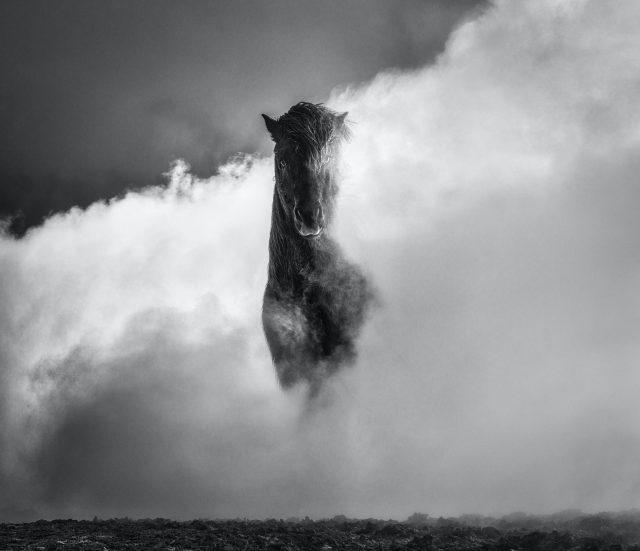
My primary goal that squally morning, high on the hills above Lochcarron, was to take a portrait of a big stag that would have a sense of place. It was important therefore to work with a lens wide enough to offer enough background detail that those familiar with the region could identify Skye in the background.
That side of the quest was less of a challenge than getting close enough to a big stag. They are skittish at best, but they were familiar with my fixer –Colin Murdoch – and that was the break that I needed.
When the moment came with this 12 pointer, it was imperative to have my focus pin sharp on his head – without that, there would certainly be no picture. The other important factor was that I wanted the stag to look regal and not nervous. Whilst camera focus is under my control, the posture of the stag is largely down to “the gods”. I just had to make myself as small and
unthreatening as possible.
I first saw this image as a big print in our gallery in Paris and it grabbed the eye. There is not much I would really change. Even a few Parisians recognised Skye in the background.
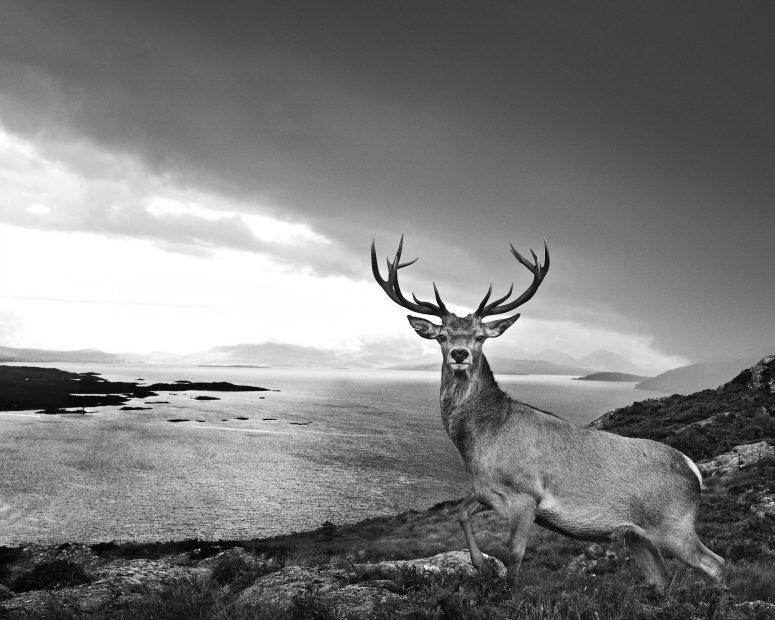
To the best of my knowledge, I don’t think that I have ever photographed swans well before – and indeed most images that I do see on Google or elsewhere, struggle to beat the threshold of what is banal. Swans are not uncommon and we all have access to the Serpentine in London or village ponds across the country. I can’t conceive how a picture taken in such a setting that would be evocative or eye grabbing. Swans have become an inadvertent accomplice to lazy postcard photography.
This is all very harsh on the swan – it is such a majestic bird – with attitude, dignity and above all grace. Tchaikovsky opened our eyes to this 140 years ago and subsequent generations of celebrated stage choreographers have reinforced our adoration for the swan. The ballet probably forged the notion that swans are at home dancing in the snow and ice – a far more aesthetically pleasing concept than imaging them scrapping around in a muddy park in Berkshire.
Russia gave the world Swan Lake and have earned the right to dictate climatic associations. Just as Dr Zhivago could never have been filmed in the summer, swans are surely best photographed in the bitter winter. It is the winter that personifies Russia and Northern Asia, not the summer.
The romanticist within me had a preconception of where I could take a strong swan image and today the twin forces of research and luck came together shortly before 8.30am on the frozen ice of Lake Kussharo in Northern Hokkaido, Japan. My central premise was that there should be as much white in the picture as possible – white from the snow, white from the ice and of course white from the whooper swan’s pristine plume of feathers. The greater the cocktail of whites, the greater the possibility of an image that could be ethereal as well as evocative. My approach was to create a dream, not necessarily report on reality
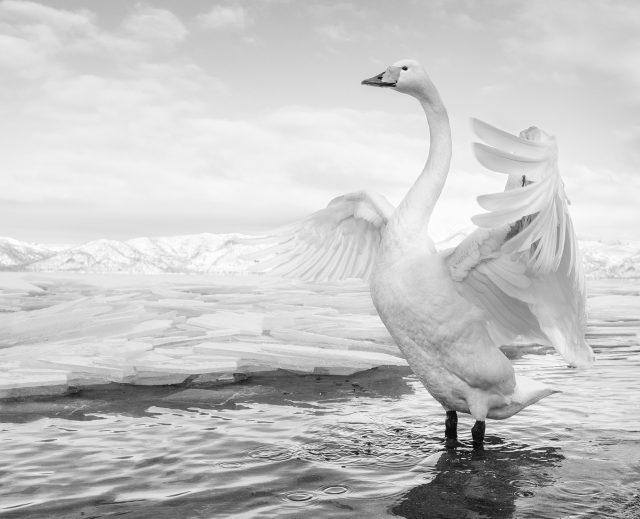
The image is made complete by its own lack of completeness – the storytelling is started by the camera and finished by the viewer.
The irony was that it was the very last of a sequence of 60 images I took of the polar bear. A second after this moment, this most solitary of predators was over the horizon and our paths will never cross again. I did not press the trigger with this image in mind – it was such an intense 15 minutes that it would be most disingenuous to suggest that it was preconceived. The heart was beating too fast to consider creating art – these moments sometimes just happen.
I am only too aware that after the success in the Sotheby’s auction in New York, there will be a bit of added interest in lot 72 and will probably come under the hammer around 430 UK time. It is slightly unnerving that my prices are now very much being watched – it’s only taken 36 years.
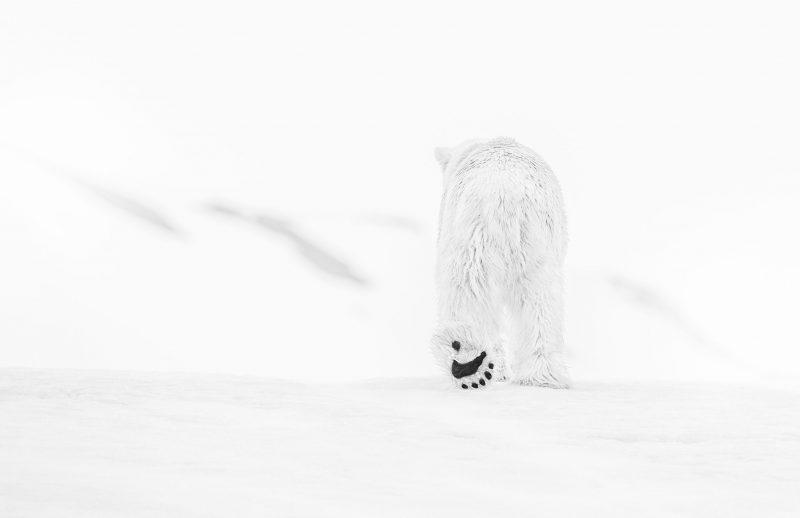
 YARROW
YARROW
This is a big picture, but quite clearly an extremely lucky one. It is said that luck is the residue of design, but on this occasion, I think it would be disingenuous to suggest that we can attribute the capture of a flying horse to a preconceived plan.
There is a spit of sand that only appears on Bantham beach near low tide and, with a long lens, the waves can be quite pronounced behind the sand. When I scouted the site, I noted the potential of the canvas in front of me, but realised timing would be critical.
Given sunrise and low tide were just after 6 am, this meant for an extremely early start and a cold one too. The only angle that would work for me, was to be lying in the shallow sea water in front of the spit. The higher my body, the poorer the angle, so getting wet was unavoidable. The temperature, with the northerly wind, was only about three degrees above freezing.
Occasionally there’s a split second of time when everything falls into place and the end result cannot be better and the frame cannot be repeated. This was one such moment and what was most satisfying, was that we were wrapped before 90% of the nation was even awake. Our lunch was everyone else’s breakfast.
YARROW DAVIDYellowstone is earth’s largest active geyser field and I was most mindful of this when trying to find a location that encapsulated the park’s identity and character. I recognised that I also needed depth – the riddle here was that this required good light and if the trees were also to be full of snow, I was asking for a demanding climatic combination. Without fresh snow, there was no picture here. Luckily on my last day in Yellowstone, “The weather gods” were favourable and then all that was left was the need for some bison to give context and interest.
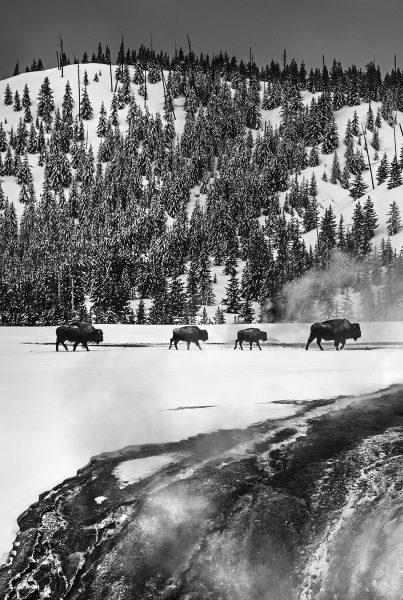
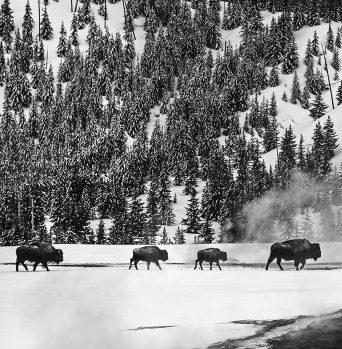
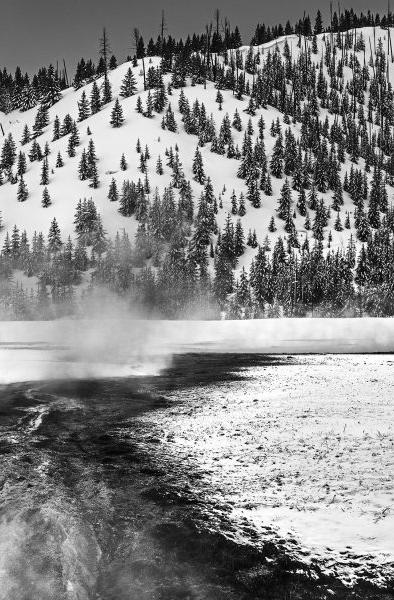
Skogafoss in southern Iceland is a familiar destination for us, we have filmed there a few times over the years and know its potential and also its challenges. The waterfall is aesthetically without equal in Europe and the backdrop offers the chance of an arresting photograph, especially as the foreground gives a platform on which to add narrative. The waterfall itself is of little interest to me; it is photographed thousands of times a day by good photographers with good cameras. It must be used as part of the story, not the whole event.
Tourists started to arrive at around were wrapped before most people were the way in Iceland. We had a small well.
This photograph should really be credited who finished off being absolutely drenched. tough up in Iceland; he didn’t complain whole experience rather entertaining.
When I looked at this image for the first I saw the seagull soaring half way up idea that it was there at the time and sense of scale to an extraordinary location.

around 9 am, which meant we were up, but that is often window and we used it credited to the horse farmer drenched. They make them complain once and found the entertaining.
first time on a big screen, up the waterfall. I had no and I think it lends further location. That is pure luck.

